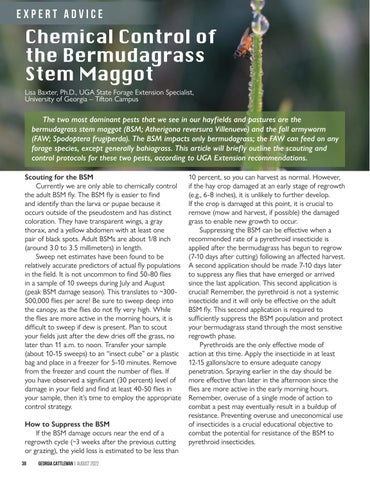Expert advice
Chemical Control of the Bermudagrass Stem Maggot Lisa Baxter, Ph.D., UGA State Forage Extension Specialist, University of Georgia – Tifton Campus
The two most dominant pests that we see in our hayfields and pastures are the bermudagrass stem maggot (BSM; Atherigona reversura Villenueve) and the fall armyworm (FAW; Spodoptera frugiperda). The BSM impacts only bermudagrass; the FAW can feed on any forage species, except generally bahiagrass. This article will briefly outline the scouting and control protocols for these two pests, according to UGA Extension recommendations. Scouting for the BSM Currently we are only able to chemically control the adult BSM fly. The BSM fly is easier to find and identify than the larva or pupae because it occurs outside of the pseudostem and has distinct coloration. They have transparent wings, a gray thorax, and a yellow abdomen with at least one pair of black spots. Adult BSMs are about 1/8 inch (around 3.0 to 3.5 millimeters) in length. Sweep net estimates have been found to be relatively accurate predictors of actual fly populations in the field. It is not uncommon to find 50-80 flies in a sample of 10 sweeps during July and August (peak BSM damage season). This translates to ~300500,000 flies per acre! Be sure to sweep deep into the canopy, as the flies do not fly very high. While the flies are more active in the morning hours, it is difficult to sweep if dew is present. Plan to scout your fields just after the dew dries off the grass, no later than 11 a.m. to noon. Transfer your sample (about 10-15 sweeps) to an “insect cube” or a plastic bag and place in a freezer for 5-10 minutes. Remove from the freezer and count the number of flies. If you have observed a significant (30 percent) level of damage in your field and find at least 40-50 flies in your sample, then it’s time to employ the appropriate control strategy. How to Suppress the BSM If the BSM damage occurs near the end of a regrowth cycle (~3 weeks after the previous cutting or grazing), the yield loss is estimated to be less than 38
GEORGIA CATTLEMAN | AUGUST 2022
10 percent, so you can harvest as normal. However, if the hay crop damaged at an early stage of regrowth (e.g., 6-8 inches), it is unlikely to further develop. If the crop is damaged at this point, it is crucial to remove (mow and harvest, if possible) the damaged grass to enable new growth to occur. Suppressing the BSM can be effective when a recommended rate of a pyrethroid insecticide is applied after the bermudagrass has begun to regrow (7-10 days after cutting) following an affected harvest. A second application should be made 7-10 days later to suppress any flies that have emerged or arrived since the last application. This second application is crucial! Remember, the pyrethroid is not a systemic insecticide and it will only be effective on the adult BSM fly. This second application is required to sufficiently suppress the BSM population and protect your bermudagrass stand through the most sensitive regrowth phase. Pyrethroids are the only effective mode of action at this time. Apply the insecticide in at least 12-15 gallons/acre to ensure adequate canopy penetration. Spraying earlier in the day should be more effective than later in the afternoon since the flies are more active in the early morning hours. Remember, overuse of a single mode of action to combat a pest may eventually result in a buildup of resistance. Preventing overuse and uneconomical use of insecticides is a crucial educational objective to combat the potential for resistance of the BSM to pyrethroid insecticides.













